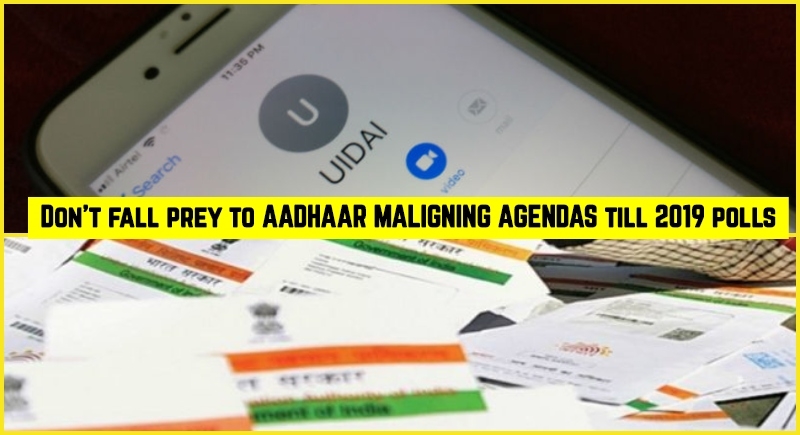‘Curious case of UIDAI Number in Your Phone’: Don’t fall prey to Aadhaar maligning agendas till 2019 polls

The problem was first reported by a French security researcher Eliot Anderson. On 2nd Aug., he tweeted at 0:22 hrs, “Hi @UIDAI, Many people, with a different provider, with and without an #Aadhaar card, with and without the mAadhaar app installed, noticed that your phone number is predefined in their contact list by default and so without their knowledge. Can you explain why? Regards,” His tweet started a conversation almost immediately; but got traction only when prominent web portals started reporting it in the afternoon of 3rd Aug. 2018.
It forced UIDAI to react. UIDAI issued a Press Statement in which, it said “#In the wake of some media reports on default inclusion of UIDAI’s outdated & invalid Toll-free no. 1800-300-1947 in the contact list of Android phones. It is clarified that UIDAI has not asked or communicated to any manufacturer or service provider for providing any such facility whatsoever. It is emphasised that the said 18003001947 is not a valid UIDAI Toll-free number and some vested interest are trying to create unwarranted confusion in the public. Our valid Toll-free number is 1947 which is functional for more than the last two years. UIDAI has reiterated that it has not asked or advised anyone including any telecom service providers or mobile manufacturers or Android to include 18003001947 or 1947 in the default list of public service numbers.”
Eliot Anderson rebutted it by posting a picture of Aadhaar card with the 11 digits toll-free number printed on it. But the card was issued before 2 years.
Any of the OEM manufacturers, mobile carriers, Operating systems (OS) and various apps, which we download and give consent to access our contacts, can add contacts in our phonebook without our prior knowledge. Thinking logically, only android or some of the large OEMs and carriers have that kind of capabilities. But UIDAI’s clarification prima facie ruled them out and zeroed in the doubt on the fourth i.e. mobile apps. Initially, it was speculated that some hacker has attacked some of the popular apps and by accessing their user database, succeeded in editing phonebooks of their subscribers. But the motive behind it was not clear. Therefore it became imperative for investigating agencies to take cognisance of the matter and quickly find out how and why did it happen?
The answer to why Aadhaar is more important than how. India is going to have general elections in 2019. This would be the first elections when more than 50 crore Indians will access to the internet and more than 90% of voters have an Aadhaar card. Aadhaar is one of the issues that have divided the political spectrum. Generally, it is observed that, political parties, when they are in power, support Aadhaar and oppose it when they are in the opposition.
The Modi Government had made Aadhaar compulsory for a host of services and welfare measures, including bank accounts, PAN cards, cellphone services, passport and even driving licenses. It was made the over-arching proof of identity and residence, over-riding all other prior identity proofs.
27 petitions have challenged the constitutional validity of AADHAR in the Supreme Court. Citing 'privacy breach' the petitioners argued that Aadhaar - built on a mammoth biometric database comprising fingerprints and iris scans - cannot be made mandatory. They also raised fears about the security of the database, citing a number of instances of a data breach.
On the backdrop of the incidents of meddling; allegedly by Russian hackers; during the referendum on BREXIT in the UK and the presidential elections in the US in 2016, it won’t be surprising if such incidents take place to influence the Indian elections. When people see UIDAI number saved in their mobile, read speculative reports on it on the internet, receive similar but politically charged messages on Facebook or WhatsApp and listen to political leaders alleging scandals, they would believe that Aadhaar is not safe. Therefore it was important that investigating agencies go to the root of it and unmask those who were behind it.
Late in the evening, Google accepted that it had in 2014 inadvertently coded the 112 distress number and the UIDAI number into its setup wizard for Android. This clarification put a quick end to the controversy but reminded us once again that we need to be on our toes in our preparedness to check cyber-attacks as well as misinformation war, which could be even more damaging than a cyber-attack. We should refrain from believing in rumours and spreading them in social media.

